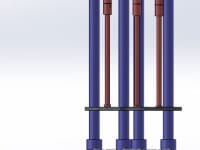Sustainable Energies is now one of the prominent ways forward to solve the energy crisis and hence we present our idea based on Tidal Energy recovery and conversion to electrical energy via means of High Head Turbines.
This project is related to power generating apparatus suitable for use in extracting energy from the movement of water, particularly tidal movement. As we know, this type of energy is generated by the relative motion of the Earth, Sun and the Moon, which interact via gravitational forces. Periodic changes of water levels, and associated tidal currents, are due to the gravitational attraction by the Sun and Moon. Tidal power generating systems have been studied for a number of years both in the form of barrages (similar to conventional hydroelectric dams in that the power extraction depends on the hydrostatic head), as well as tidal devices which exploit directly the kinetic energy of tidal streams.
However there is one basic constraint of using barrages as they are location specific i.e. coastal areas. Our proposed system eliminates the constraint of location and can be utilized at any location in open sea areas.
The system uses the difference in height of sea level due to tide and convert it into electricity by using piston and cylinder mechanism to create head which is used to run high head turbine to generate electricity.
Our calculation involves the basic parameters and assumes a power generation of 1 MW which is to be achieved by set of turbines connected to a pontoon (floating on the surface at sea level). When tide will occur, the pontoon will rise along with a piston connected to it rigidly, pushing the fluid in piston through the pipes and eventually going through the Turbine generating a case of constant head due to high volume availability of fluid in the setup already. The piston will generate energy in return stroke as well due to the hanging weight of the pontoon and hence increasing the overall efficiency of the system.
Here is a gist of basic calculations used in so.
No of Pistons – n
Stroke Length – L
Surface Area of Piston – A
Total Volume (V) – n*A*L
V = Flow rate*Time*C
Where C = conversion factor of hours to seconds and m3 to litres.
From flow rate and flow time we calculated the required characteristics of the fluid based on the time period and stay of tides.
Use of CAE tools could be utilized to identify the most suitable design for pontoon and its surface area in order to enhance the capability of the system.
Our proposed system projects a power generation unit of 1 MW at the installation of 20 pistons cumulatively.
We invite you to suggest your valuable ideas to improve us and to step towards a sustainable world.
Like this entry?
-
About the Entrant
- Name:Manish Kumar
- Type of entry:teamTeam members:Manish Kumar
Aditya Shukla - Software used for this entry:SolidWorks
- Patent status:pending





